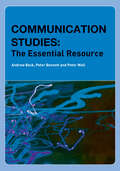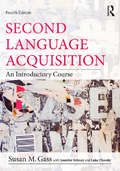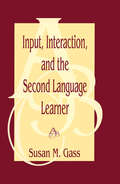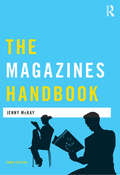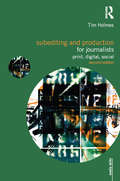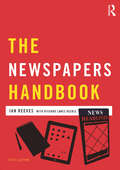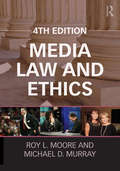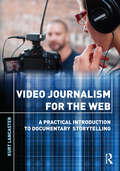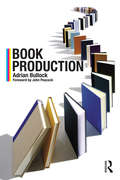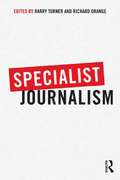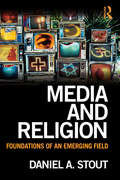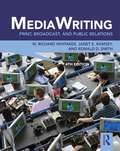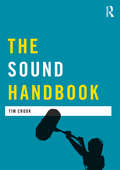- Table View
- List View
Communication Studies: The Essential Resource
by Andrew Beck Peter Bennett Peter WallThis book brings together a huge range of material including academic articles, film scripts and interplanetary messages adrift on space probes with supporting commentary to clarify their imporatance to the field. Communication Studies: The Essential Resource is a collection of essays and texts for all those studying communication at university and pre-university level. Individual sections address: * texts and meanings in communication* themes in personal communication* communication practice* culture, communication and context* debates and controversies in communication.Edited by the same teachers and examiners who brought us AS Communication Studies: The Essential Introduction, this volume will help communications students to engage with the subject successfully. Its key features include: * suggested further activities at the end of each chapter* a glossary of key terms* a comprehensive bibliography with web resources.
Second Language Acquisition: An Introductory Course
by Susan M. GassNow in a fourth edition, this bestselling introductory textbook remains the cornerstone volume for the study of second language acquisition (SLA). Its chapters have been fully updated, and reorganized where appropriate, to provide a comprehensive yet accessible overview of the field and its related disciplines. To reflect current developments, new sections on using learner corpora, semantics and morphosyntax (within formal approaches to SLA), sociocultural approaches, gesture, priming research, and chaos theory have been added. Students will also find expanded discussions of heritage language learning, bilingualism, pragmatics, and much more. The redesigned fourth edition of Second Language Acquisition retains the features that students found useful in the current edition but also provides new pedagogical tools that encourage students to reflect upon the experiences of second language learners. As with previous editions, discussion questions and problems at the end of each chapter help students apply their knowledge, and a glossary defines and reinforces must-know terminology. This clearly-written, comprehensive, and current textbook, by expert Sue Gass, is the ideal textbook for the introductory SLA course in second language studies, applied linguistics, linguistics, TESOL, and language education programs.
Second Language Acquisition: An Introductory Course
by Susan M. GassNow in a fourth edition, this bestselling introductory textbook remains the cornerstone volume for the study of second language acquisition (SLA). Its chapters have been fully updated, and reorganized where appropriate, to provide a comprehensive yet accessible overview of the field and its related disciplines. To reflect current developments, new sections on using learner corpora, semantics and morphosyntax (within formal approaches to SLA), sociocultural approaches, gesture, priming research, and chaos theory have been added. Students will also find expanded discussions of heritage language learning, bilingualism, pragmatics, and much more. The redesigned fourth edition of Second Language Acquisition retains the features that students found useful in the current edition but also provides new pedagogical tools that encourage students to reflect upon the experiences of second language learners. As with previous editions, discussion questions and problems at the end of each chapter help students apply their knowledge, and a glossary defines and reinforces must-know terminology. This clearly-written, comprehensive, and current textbook, by expert Sue Gass, is the ideal textbook for the introductory SLA course in second language studies, applied linguistics, linguistics, TESOL, and language education programs.
Input, Interaction, and the Second Language Learner
by Susan M. GassThis volume provides a definitive view of the relationship between input, interaction, and second language acquisition. In so doing, it should prove useful to those whose major concern is with the acquisition of a second or foreign language as well as for those who are primarily interested in these issues from a pedagogical perspective. The book does not explicate or advocate a particular teaching methodology, but does attempt to lay out some of the underpinnings of what is involved in interaction -- what it is and what purpose it serves.Research in second language acquisition is concerned with the knowledge that second language learners do and do not acquire and how that knowledge comes about. This book ties these issues together from three perspectives -- input/interaction framework, information-processing, and learnability.
Input, Interaction, and the Second Language Learner
by Susan M. GassThis volume provides a definitive view of the relationship between input, interaction, and second language acquisition. In so doing, it should prove useful to those whose major concern is with the acquisition of a second or foreign language as well as for those who are primarily interested in these issues from a pedagogical perspective. The book does not explicate or advocate a particular teaching methodology, but does attempt to lay out some of the underpinnings of what is involved in interaction -- what it is and what purpose it serves.Research in second language acquisition is concerned with the knowledge that second language learners do and do not acquire and how that knowledge comes about. This book ties these issues together from three perspectives -- input/interaction framework, information-processing, and learnability.
Promoting Nonprofit Organizations: A Reputation Management Approach
by Ruth Ellen KinzeyPromoting Nonprofit Organizations is a practical guide to developing and implementing a strategic public relations program to enhance a nonprofit’s reputation. The ways in which businesses – both for-profit and not-for-profit – communicate with customers has changed dramatically in recent years. Coupled with economic uncertainty, nonprofits have had to adopt a leaner operational mode, further underlining the need for organizations to take advantage of all the promotion strategies available to them. This book: Discusses why public relations and reputation management go hand-in-hand with marketing efforts Offers a step-by-step guide to develop a public relations strategy Considers the importance of nonprofit sustainable citizenship Provides tips for reputation enhancement using a range of tools, such as social media and board ambassadorship Guides the reader in developing a reputation approach to crisis communication management Highly practical in its approach, this book is a great guide for students in public relations and nonprofit management courses, as well as for professionals seeking to enhance the success of their nonprofit organization.
Promoting Nonprofit Organizations: A Reputation Management Approach
by Ruth Ellen KinzeyPromoting Nonprofit Organizations is a practical guide to developing and implementing a strategic public relations program to enhance a nonprofit’s reputation. The ways in which businesses – both for-profit and not-for-profit – communicate with customers has changed dramatically in recent years. Coupled with economic uncertainty, nonprofits have had to adopt a leaner operational mode, further underlining the need for organizations to take advantage of all the promotion strategies available to them. This book: Discusses why public relations and reputation management go hand-in-hand with marketing efforts Offers a step-by-step guide to develop a public relations strategy Considers the importance of nonprofit sustainable citizenship Provides tips for reputation enhancement using a range of tools, such as social media and board ambassadorship Guides the reader in developing a reputation approach to crisis communication management Highly practical in its approach, this book is a great guide for students in public relations and nonprofit management courses, as well as for professionals seeking to enhance the success of their nonprofit organization.
The Magazines Handbook
by Jenny McKayThe Magazines Handbook has firmly established itself as the essential introduction to the theories and practices of the modern magazine industry. This fully updated third edition comprehensively examines the business of publishing magazines today and the work of the contemporary magazine journalist. Jenny McKay draws examples from a broad range of publications to explore key jobs in the industry, covering everyone from the sub editor to the fashion assistant, as well as analysing the many skills involved in magazine journalism, including commissioning, researching, interviewing, and production. Updated specialist chapters discuss the growth and development of electronic publishing and online journalism, new directions in magazine design, photography and picture editing, and the most up to date legal frameworks in which magazine journalists must operate. The Magazines Handbook includes: • Interviews with magazine journalists, editors, and publishers • Advice on starting out and freelancing in the magazine industry • An analysis of ‘new journalism’ and reportage • A glossary of key terms and specialist concepts • Information on contacts, courses and professional training.
The Magazines Handbook
by Jenny McKayThe Magazines Handbook has firmly established itself as the essential introduction to the theories and practices of the modern magazine industry. This fully updated third edition comprehensively examines the business of publishing magazines today and the work of the contemporary magazine journalist. Jenny McKay draws examples from a broad range of publications to explore key jobs in the industry, covering everyone from the sub editor to the fashion assistant, as well as analysing the many skills involved in magazine journalism, including commissioning, researching, interviewing, and production. Updated specialist chapters discuss the growth and development of electronic publishing and online journalism, new directions in magazine design, photography and picture editing, and the most up to date legal frameworks in which magazine journalists must operate. The Magazines Handbook includes: • Interviews with magazine journalists, editors, and publishers • Advice on starting out and freelancing in the magazine industry • An analysis of ‘new journalism’ and reportage • A glossary of key terms and specialist concepts • Information on contacts, courses and professional training.
Subediting and Production for Journalists: Print, Digital & Social (Media Skills)
by Tim HolmesThe new edition of Subediting and Production for Journalists is a concise, clear and contemporary introduction to the skills required for subediting newspapers, magazines and websites. Tim Holmes describes how subediting has developed, from the early days of print to the modern era of the internet browser and social media, and explores the many challenges for the sub working today. Using numerous practical examples drawn from print and online, Subediting and Production for Journalists introduces the various techniques employed by the sub to help make the written word stand out on the page, including: subbing news and features for sense and style writing headlines and sells making copy legally safe understanding production, using software packages and content management systems editing and rewriting stories for online publication creating suitable page furniture for websites handling and sizing pictures digitally handling audio and video. Subediting and Production for Journalists is the perfect guide for all those with an interest in subbing in today’s multimedia environments, as well as anyone wanting to see their words come to life.
The Newspapers Handbook
by Richard Keeble Ian ReevesThis new edition of The Newspapers Handbook presents an enlightening examination of an ever-evolving industry, engaging with key contemporary issues, including reporting in the digital age and ethical and legislative issues following the hacking scandal to display a comprehensive anatomy of the modern newsroom. Richard Lance Keeble and Ian Reeves offer readers expert practical advice, drawing on a wide range of examples from print and digital news sources to illustrate best practice and the political, technological and financial realities of newspaper journalism today. Other key areas explored include: the language of news basic reporting the art of interviewing feature writing the role of social media in reporting investigative reporting court reporting reporting on national and local government guidance on training and careers for those entering the industry.
The Newspapers Handbook
by Richard Keeble Ian ReevesThis new edition of The Newspapers Handbook presents an enlightening examination of an ever-evolving industry, engaging with key contemporary issues, including reporting in the digital age and ethical and legislative issues following the hacking scandal to display a comprehensive anatomy of the modern newsroom. Richard Lance Keeble and Ian Reeves offer readers expert practical advice, drawing on a wide range of examples from print and digital news sources to illustrate best practice and the political, technological and financial realities of newspaper journalism today. Other key areas explored include: the language of news basic reporting the art of interviewing feature writing the role of social media in reporting investigative reporting court reporting reporting on national and local government guidance on training and careers for those entering the industry.
Media Law and Ethics
by Roy L. Moore Michael D. Murray Michael Farrell Kyu Ho YoumThis is the first textbook to explicitly integrate both media law and ethics within one volume. A truly comprehensive overview, it is a thoughtful introduction to media law principles and cases and the related ethical concerns relevant to the practice of professional communication. With special attention made to key cases and practices, authors Roy L. Moore and Michael D. Murray revisit the most timely and incendiary issues in modern American media. Exploring where the law ends and ethics begin, each chapter includes a discussion of the ethical dimensions of a specific legal topic. The Fourth Edition includes new legal cases and emerging issues in media law and ethics as well as revised subject and case indices. In addition to a separate chapter devoted exclusively to media ethics by Michael Farrell, a new chapter on international and foreign law by Dr. Kyu Ho Youm has also been added. Resources on the companion website include updated PowerPoint presentations and a sample syllabus for instructors, and a glossary, chapter review questions, chapter quizzes, and all seven of the book’s original appendices for students. An excellent integration of both law and ethics, this is the ideal text for undergraduate and graduate courses in media law and ethics.
Video Journalism for the Web: A Practical Introduction to Documentary Storytelling
by Kurt LancasterAs newspapers and broadcast news outlets direct more resources toward online content, print reporters and photojournalists are picking up video cameras and crafting new kinds of stories with their lenses. Creating multimedia video journalism requires more than simply adapting traditional broadcast techniques: it calls for a new way of thinking about how people engage with the news and with emerging media technologies. In this guide, Kurt Lancaster teaches students and professional journalists how to shoot better video and tell better stories on the web, providing a strong understanding of cinematic storytelling and documentary production so their videos will stand out from the crowd. Video Journalism for the Web introduces students to all the basic skills and techniques of good video journalism and documentary storytelling, from shots and camera movements to sound and editing—as well as offering tips for developing compelling, character-driven narratives and using social media to launch a successful career as a "backpack journalist." Shooting, editing, and writing exercises throughout the book allow students to put these techniques into practice, and case studies and interviews with top documentary journalists provide real-world perspectives on a career in video journalism. This book gives aspiring documentary journalists the tools they need to get out in the field and start shooting unforgettable multimedia stories.
Video Journalism for the Web: A Practical Introduction to Documentary Storytelling
by Kurt LancasterAs newspapers and broadcast news outlets direct more resources toward online content, print reporters and photojournalists are picking up video cameras and crafting new kinds of stories with their lenses. Creating multimedia video journalism requires more than simply adapting traditional broadcast techniques: it calls for a new way of thinking about how people engage with the news and with emerging media technologies. In this guide, Kurt Lancaster teaches students and professional journalists how to shoot better video and tell better stories on the web, providing a strong understanding of cinematic storytelling and documentary production so their videos will stand out from the crowd. Video Journalism for the Web introduces students to all the basic skills and techniques of good video journalism and documentary storytelling, from shots and camera movements to sound and editing—as well as offering tips for developing compelling, character-driven narratives and using social media to launch a successful career as a "backpack journalist." Shooting, editing, and writing exercises throughout the book allow students to put these techniques into practice, and case studies and interviews with top documentary journalists provide real-world perspectives on a career in video journalism. This book gives aspiring documentary journalists the tools they need to get out in the field and start shooting unforgettable multimedia stories.
Book Production
by Adrian BullockThe digital revolution has brought with it a wider range of options for creating and producing print on paper products than ever seen before. With the growing demand for skills and knowledge with which to exploit the potential of digital technology, comes the need for a comprehensive book that not only makes it possible for production staff, editors, and designers to understand how the technology affects the industry they work in, but also provides them with the skills and competencies they need to work in it smartly and effectively. This book is designed to satisfy this need. Book Production falls into two parts: The first part deals with the increasingly important role of production as project managers, a role which has not been adequately written about in any of the recent literature on publishing. The second part deals with the processes and raw materials used in developing and manufacturing print on paper products. Case studies are used to illustrate why and how some processes or raw materials may or may not be appropriate for a particular job. With expert opinions and case studies, and a consideration of the practices and issues involved, this offers a comprehensive overview of book production for anyone working, or training to work in or in conjunction with the books industry.
Specialist Journalism
by Barry Turner Richard OrangeCombining practical 'how to' skills with reflection on the place of each specialism in the industry, this guide features the skills needed to cover specialist areas, including writing match reports for sport, reviewing the arts, and dealing with complex information for science. The book will also discuss how specialist journalists have contributed to the mainstream news agenda, as well as analysing how different issues have been covered in each specialism, such as the credit crunch, global warming, national crime statistics and the celebrity culture in sport. Areas covered include: Sport Business Politics Crime Environment Fashion Food Music Media Science Health Law Travel War Wine
Specialist Journalism
by Barry Turner Richard OrangeCombining practical 'how to' skills with reflection on the place of each specialism in the industry, this guide features the skills needed to cover specialist areas, including writing match reports for sport, reviewing the arts, and dealing with complex information for science. The book will also discuss how specialist journalists have contributed to the mainstream news agenda, as well as analysing how different issues have been covered in each specialism, such as the credit crunch, global warming, national crime statistics and the celebrity culture in sport. Areas covered include: Sport Business Politics Crime Environment Fashion Food Music Media Science Health Law Travel War Wine
Media and Religion: Foundations of an Emerging Field
by Daniel A. StoutThis text examines the history, theory, cultural context, and professional aspects of media and religion. While religion has been explored more fully in psychology, sociology, anthropology, and the humanities, there is no clear bridge of understanding to the communication discipline. Daniel A. Stout tackles this issue by providing a roadmap for examining this understudied area so that discussions about media and religion can more easily proceed. Offering great breadth, this text covers key concepts and historical highlights; world religions, denominations, and cultural religion; and religion and specific media genres. The text also includes key terms and questions to ponder for every chapter, and concludes with an in-class learning activity that can be used to encourage students to explore the media–religion interface and review the essential ideas presented in the book. Media and Religion is an ideal introduction for undergraduate students in need of a foundation for this emerging field.
Media and Religion: Foundations of an Emerging Field
by Daniel A. StoutThis text examines the history, theory, cultural context, and professional aspects of media and religion. While religion has been explored more fully in psychology, sociology, anthropology, and the humanities, there is no clear bridge of understanding to the communication discipline. Daniel A. Stout tackles this issue by providing a roadmap for examining this understudied area so that discussions about media and religion can more easily proceed. Offering great breadth, this text covers key concepts and historical highlights; world religions, denominations, and cultural religion; and religion and specific media genres. The text also includes key terms and questions to ponder for every chapter, and concludes with an in-class learning activity that can be used to encourage students to explore the media–religion interface and review the essential ideas presented in the book. Media and Religion is an ideal introduction for undergraduate students in need of a foundation for this emerging field.
Strategic Conflict
by Daniel J. Canary Sandra LakeyStrategic Conflict offers a research-based, accessible analysis of how people can manage conflict productively. Moving beyond the basics of conflict, it examines interpersonal situations in which conflict occurs and promotes strategic communicative responses based on the latest theoretical research. Daniel J. Canary and his colleagues add personal observations, media examples, and samples of actual interaction to provide concrete illustrations of the research findings. This comprehensive volume provides students with the tools to understand conflict in real-world contexts. ?
Strategic Conflict
by Daniel J. Canary Sandra LakeyStrategic Conflict offers a research-based, accessible analysis of how people can manage conflict productively. Moving beyond the basics of conflict, it examines interpersonal situations in which conflict occurs and promotes strategic communicative responses based on the latest theoretical research. Daniel J. Canary and his colleagues add personal observations, media examples, and samples of actual interaction to provide concrete illustrations of the research findings. This comprehensive volume provides students with the tools to understand conflict in real-world contexts. ?
MediaWriting: Print, Broadcast, and Public Relations
by W. Richard Whitaker Janet E. Ramsey Ronald D. SmithMediaWriting is an introductory, hands-on textbook for students preparing to write in the current multimedia environment. Rather than just talk about the differences among the styles of print, broadcast, and public relations, MediaWriting sythensizes and integrates them, while weaving in basic principles of Internet writing and social media reporting. Complete with real-world examples, practical writing exercises, and tips and information for entering into the profession, MediaWriting continues to give students the tools they need to become a successful media writer. The new edition has been extensively rewritten to reflect the dynamic nature of the profession, paying significant attention to how the Internet and social media have become essential communication tools for print and broadcast journalists, and public relations professionals. Further updates and features include: Increased attention to computer-assisted reporting, the preparation of online copy, and social media applications Two new chapters on lead writing and new new media A separate chapter focused solely on ethics Explanatory "how to" boxes that help students understand and retain main themes Illustrative "It Happened to Me" vignettes from the authors’ professional experiences Discussion questions and exercises at the end of every chapter Suggested readings that highlight biographies, books, and websites that expand the scope and definition of professionalism In addition to new multimedia elements, the fourth edition’s companion website features enhanced resources for both students and instructors, including chapter overviews, writing tips, a test bank, sample critiques, and a sample syllabus.
MediaWriting: Print, Broadcast, and Public Relations
by W. Richard Whitaker Janet E. Ramsey Ronald D. SmithMediaWriting is an introductory, hands-on textbook for students preparing to write in the current multimedia environment. Rather than just talk about the differences among the styles of print, broadcast, and public relations, MediaWriting sythensizes and integrates them, while weaving in basic principles of Internet writing and social media reporting. Complete with real-world examples, practical writing exercises, and tips and information for entering into the profession, MediaWriting continues to give students the tools they need to become a successful media writer. The new edition has been extensively rewritten to reflect the dynamic nature of the profession, paying significant attention to how the Internet and social media have become essential communication tools for print and broadcast journalists, and public relations professionals. Further updates and features include: Increased attention to computer-assisted reporting, the preparation of online copy, and social media applications Two new chapters on lead writing and new new media A separate chapter focused solely on ethics Explanatory "how to" boxes that help students understand and retain main themes Illustrative "It Happened to Me" vignettes from the authors’ professional experiences Discussion questions and exercises at the end of every chapter Suggested readings that highlight biographies, books, and websites that expand the scope and definition of professionalism In addition to new multimedia elements, the fourth edition’s companion website features enhanced resources for both students and instructors, including chapter overviews, writing tips, a test bank, sample critiques, and a sample syllabus.
The Sound Handbook (1st Edition) (PDF)
by Tim Crook'Tim Crook has written an important and much-needed book, and its arrival on our shelves has come at a highly appropriate time.' Professor Sen Street, Bournemouth University The Sound Handbook maps theoretical and practical connections between the creation and study of sound across the multi-media spectrum of film, radio, music, sound art, websites, animation and computer games entertainment, and stage theatre. Using an interdisciplinary approach Tim Crook explores the technologies, philosophies and cultural issues involved in making and experiencing sound, investigating soundscape debates and providing both intellectual and creative production information. The book covers the history, theory and practice of sound and includes practical production projects and a glossary of key terms. The Sound Handbook is supported by a companion website, signposted throughout the book, with further practical and theoretical resources dedicated to bridging the creation and study of sound across professional platforms and academic disciplines.
